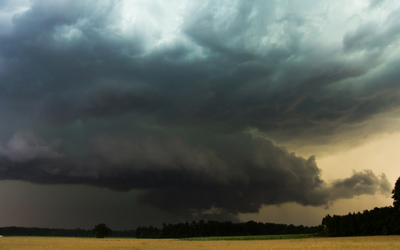
This year has already brought severe weather to parts of the globe. Heavy snow and strong winds hit the southern and northeastern United States in early January, while Australia has been experiencing record breaking temperatures leaving melted asphalt and massive bushfires, forcing many to leave their homes. Volcanic activity in Hawaii and earthquakes in Mexico and Papua New Guinea have also left many homeless.
With summer just around the corner, hurricane season has already begun with the first named Atlantic storm hitting the Gulf of Mexico area in late May, and over 300 tornadoes have been confirmed in the US so far this year.
June marks National Pet Preparedness Month – a time to ensure that you are prepared for an emergency – not only for you, but your pets as well. The safety and survival of our pets lies solely on us, as pet owners, so take some time this week to make sure you have all the supplies you need for your pet in case you are faced with an emergency.
The following are items you should have packed in a “pet emergency kit.” Have this kit ready to take with you in case of evacuation:
- Bottled water. In many emergency situations, water becomes contaminated and tap water is not safe to drink. You should have a 72 hour water supply – for both you and your pet. But just how much water is a 72 hour supply?
- A normally active person needs about ¾ of a gallon (about 3 litres) of water (or other fluids) daily. In other words, for 72 hours, each person in your household needs about 2½ gallons (9 litres) of water. For pets, this amount varies depending on the size of the animal.
- Generally a dog will drink between ½ and 1 ounce (15-30 mL) of water per pound of body weight per day. In other words, a 65-pound (30 kg) dog will drink between ¼-½ gallon (1-2 litres) of water daily. For 72 hours, this sized dog would need about ¾-1½ gallons (3-6 litres) of water.
- A cat’s daily water requirement is about 5-10 ounces (150 – 300 mL) of water per day. A cat would need about 15-30 ounces (450-900 mL) of water for 72 hours.
In extreme heat, these needs will of course be higher.
- Be sure to have a 72 hour food supply, including food (and water) bowls and a can opener if you feed your pet canned food. Be sure to swap out food every few months to ensure that it stays fresh.
- Keep a supply of your pet’s medication in your pet’s emergency kit. This is extremely important if your pet’s life depends on the medication. Swap out medication frequently, so you that you always have fresh medication in your kit.
- Medical records and identification. Keep a copy of your pet’s medical records, along with your veterinarian’s contact information in your emergency kit. It’s also wise to keep a photo of your pet in the kit in case you are separated from your pet. If your pet is microchipped, keep a copy of his microchip number in the kit.
- Toys, blankets, towels. These familiar items will help reduce the stress your pet will undoubtedly experience if you must evacuate your home. Consider rotating these items in the kit so that they remain familiar to your pet.
- Waste bags and hand wipes. Be sure to pack plenty of waste collection bags, and since water for handwashing may be limited, pack wipes for quick hand cleaning.
- Brush and comb. Be sure to pack a comb or brush in your pet’s emergency kit. If your pet gets wet, you should towel him off and brush him well to avoid mats or hot spots.
- Leash, collar, harness, crate. A carrying crate is especially important when evacuating a cat. A sturdy leash and harness will help keep your dog safe and under control when evacuating – your pets may sense the distress and not respond to your commands as they normally would.
ALWAYS TAKE YOUR PETS WITH YOU. Never leave your pets behind thinking that you can get them later – conditions can deteriorate quickly and you may not be able to return to your home.
ALWAYS HAVE A BACK-UP PLAN. Be sure that a friend or neighbor has access to your home to retrieve your pet and emergency kit if you are unable to return home when an evacuation order is issued.
Take a moment this weekend to prepare or update your pet’s emergency kit with all the vital necessities and come up with an emergency plan with your family that includes your pets. With any luck, you will not need the kit this summer, but it is better to be prepared – your pet is depending on you!